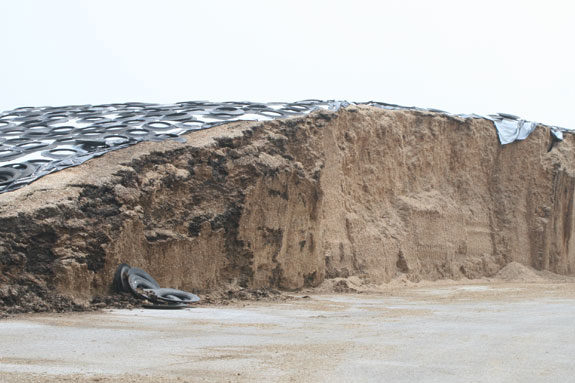As we approach the end of summer and start scraping the bottom of the silo or pit to feed our dairy herd before the 2011 harvest season begins, we may want to consider the quality of that silage. While last year’s harvest appeared to be cleaner than the previous year’s crop, some producers are finding that after it was all packed and stored away, it wasn’t as safe as it seemed. As the temperature has risen, so have the levels of mold and yeast in our stored feed.
Scroll down or to see a related video from Alltech on this topic.
Silage and feeding
In any fermentation storage system, temperature and the presence of moisture is sufficient for toxin production. However, oxygen is the actual component which turns mycotoxin production on or off during storage.
According to the site www.knowmycotoxins.com, the amount of mycotoxins in contaminated silage samples increases as the ensilement method changes from airtight, upright silos to concrete capped and uncapped silos. The highest forage concentrations of mycotoxins are found in horizontal storage methods such as bunker silos and feed piles which are left open to oxygen.
Where greater amounts of mycotoxins are found, poor management of the upright or bunker silo has resulted in oxygen entering the stored feed. In scientific studies, well managed bunker silos, covered with plastic and weighted with tires, did not have significantly greater levels of mycotoxins than well managed upright silos.
In a plastic covered storage system, oxygen penetration is slowed but not eliminated. The longer the silage is stored, the greater the opportunity for significant fungus growth and mycotoxin contamination.
There is no such thing as an oxygen proof silo. We would all like to think this is true, but in practical terms our current technologies are not perfect.
When one examines a plastic layer under a microscope, he will find tiny holes through which oxygen slowly flows. This is especially true of plastic that is stretched for wrapping bales. Any damage to the plastic further increases the flow of oxygen from a trickle to a river and must be repaired as quickly as possible.
Different molds have different homes
While Fusarium molds predominately occur in the field and contaminate the growing crop, there are other molds and mycotoxins that feast on stored feeds. Penicillium molds such as Penicillium roqueforti are key contaminants and these molds bring with them different challenges. The most famous compound produced by the Penicillium mold species is the antibiotic penicillin. It is therefore not surprising that several of the compounds also have antibiotic properties
Silage and stored feed are perfect energy sources so producers, nutritionists and veterinarians should be aware of storage molds, particularly the Penicillium species, because of their ability to impact rumen function. Since a test is not commercially available currently to test for Penicillium mycotoxins, running a mold test and identification can be a useful way to identify the presence of these molds.
Facing the problem
While ensiling and storage management are key to minimizing the presence of Penicillium, all the typical factors such as forage type, dry matter, chop length, packing density and feed-out management are important areas to focus.
Here is a checklist of management techniques to minimize moldy silage:
• Harvest corn and haylage at the recommended maturity and moisture level for your storage system. DO NOT let corn stand in the field after reaching maturity or killing frost.
• Be sure chopper knives are sharp and cut at the correct length to improve packing
• Harvest forages as quickly as possible and pack tightly with the proper weight of tractor matched to the right number of packing hours and filling rate.
• Be sure the silo is sealed to exclude oxygen. Use plastic covers secured by tires on bunkers.
• Patch any holes in plastic covers, bags, or wrapped bails as soon as possible
• Discard obviously spoiled feed or layers of feed.
• Since mycotoxins are highly soluble in water, do not allow rain to wash through upper layers of spoiled feed.
• Clean out leftover feed from feeding bunks regularly.
• Consider the use of an inoculant in silage or acid additive in high moisture corn to enhance fermentation and storage ability.
• Match the rate of feed removal from the silo face to the size of the herd. For example bunker silo faces should be removed at four to six inches and upright silo face at three to four inches per day. Use the higher rate during the warm seasons.
• When confronted with a toxicity problem, stop feeding the contaminated feed.
• In consultation with your veterinarian or nutritionist, consider the use of a mycotoxin adsorbent to be mixed with the feed
Last but not least: How does Moldy Silage Syndrome affect her?
The rumen flora is the primary target of Penicillium toxins, resulting in reduced feed intake, impaired rumen function, inflammatory reactions, rumenitis, laminitis and mastitis. The process of rumen degradation generally caused by mycotoxins is accelarated by Peniciullium toxins that act as natural antimicrobials such as patulin, mycophenolic acid and penicillic acid.
A 2010 study selected dairy cows that were presenting disease conditions from three farms for experimental treatment with a yeast cell wall extract from Alltech. Eighty-five percent of the cows supplemented with the product for two weeks showed reduced levels of oxidative stress, lower somatic cell counts and increased milk production.
Bottom line for producers and nutritionists is that the dairy cow remains the best indicator of a mycotoxin presence. Therefore, if that animal is not performing to its fullest or unexplained symptoms persist; consider the role that a mycotoxin may be playing. PD
References omitted but are available upon request to editor@progressivedairy.com.
VIDEO






